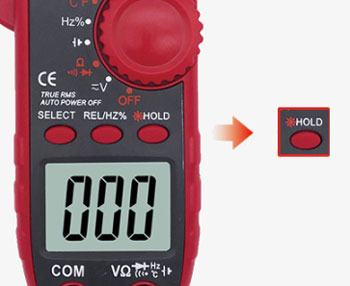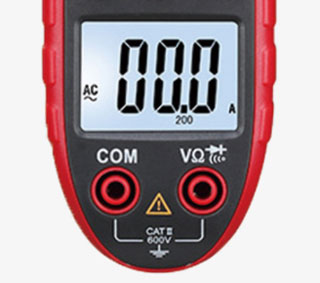High precision True-RMS clamp meter with AC current range 0-600A, TRMS function, maximum clamp size 28mm, 4 digit display, maximum value 1999, with data hold, low battery indication.

Data hold key
- Used to lock the current measurement value.
- When the real-time value needs to be maintained, press the HOLD key to judge and record.
- Function range knob, accurate gear.

LED display
- Display high-definition backlight, low voltage display.
- Wear-resistant silicone case for long service life.
- Pen socket, is smooth and stable.
Application
The clamp meter is one of the necessary test tools in daily maintenance work, mainly used to test voltage, current, frequency and other related parameters, requiring its high test resolution, test accuracy, and more test functions. Applications mainly include industrial control, industrial equipment, commercial, industrial, and residential electrical systems, and HVAC.
| Basics | Model | SISCO-UA3268A | |
| Weight | 160g | ||
| Size (L*W*H) | 185*51*25mm | ||
| Display | 4 digit LCD display | ||
| Maximum display value | 1999 | ||
| Power supply | DC 3V, 2 AAA batteries | ||
| Maximum jaw opening size | 28mm | ||
| Woring environment | Temperature: 5℃~35℃ (41℉~95℉), relative humidity:<75% | ||
| Storage temperature | -10℃~+50℃ (14℉~122℉) | ||
| Accessories | A pair of test probes, a user manual, 2 AAA batteries | ||
| Functions | Item | Range | Accuracy |
| AC current | 600A | ±(2.5%+5 digits) | |
| DC voltage | 600V | ±(1.0%+5 digits) | |
| AC voltage | 600V | ±(1.5%+5 digits) | |
| Resistance | 2MΩ | ±(1.0%+4 digits) | |
| Special functions | TRMS | True RMS measurement for sine wave signal | |
| Diode test | Display forward voltage value of diode | ||
| On-off buzzer | Continuity test buzzer | ||
| Data hold | Hold the reading when taking a measurement | ||
| Automatic power off | Automatic power off when 15 minutes no operation | ||
| Overload protection | Overload protection for 100% range | ||
| Range selection | Manual range selection | ||
| Backlight | Backlight for LCD display | ||
Q1: What is a clamp meter?
A1: A clamp meter is a device used to measure current conveniently and safely. It is very efficient to measure current without using test leads. To measure
current, all you have to do is place a wire in the jaws of the clamp meter. When current flows through a conductor, a magnetic field is created. The device helps to detect magnetic fields so that it can provide corresponding current readings, the sisco clamp meter can also be used as a multimeter.
Q2: How a clamp meter works?
A2: Clamp meters work on the principle of magnetic induction and measure alternating current without contact. Like every conductor, the current flowing
through the wire creates a magnetic field. Hall effect sensors detect the magnetic field produced by the current, which in turn creates a small voltage
across the sensor.
Q3: How often does a clamp meter need to be calibrated?
A3: A clamp meter typically needs to be calibrated annually to ensure it continues to measure within sisco's specifications.
Tips: True RMS Zero Input Characteristics of Clamp Meter
To test the measurement of a sine wave signal, the true RMS measurement method has less error than the traditional averaging response method. True RMS clamp meters accurately measure sine waves, but when the signal under test is not being input (AC voltage function selected, input shorted), the AC function may show a reading between 1 and 50. These deviated readings are normal. They do not affect the accuracy of the clamp meter in measuring AC over the specified measurement range. True RMS requires a certain level of input signal to make a measurement. Therefore, the AC voltage and current ranges are specified between 2% and 100% of the full range.
Thank you for buying industrial test and measurement equipment on SISCO.com, all products sold by SISCO and the partner cover a 12 months warranty, effective from the date of receiving the products.
What is covered?
SISCO is responsible for providing free spare parts, and free technical support to assist the customer to repair the defective products until the problem is solved.
What is not covered?
- Product purchased from anyone other than a SISCO store or a SISCO authorized reseller.
- Expendable parts.
- Routine cleaning or normal cosmetic and mechanical wear.
- Damage from misuse, abuse or neglect.
- Damage from use of parts other than SISCO approved.
- Damage from use outside the product’s usage or storage parameters.
- Damage from use of parts not sold by SISCO.
- Damage from modification or incorporation into other products.
- Damage from repair or replacement of warranted parts by a service provider other than a SISCO authorized service provider.
- Damage caused by the application environment not meeting the product usage requirements and the failure to perform preventive maintenance.

